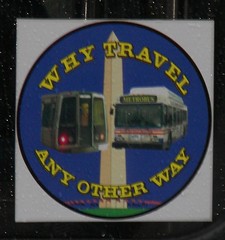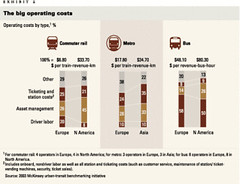Tough issues ahead on WMATA fare pricing
 Decal affixed to the sides of WMATA buses.
Decal affixed to the sides of WMATA buses.There is a lot of ferment about the WMATA fare increase proposals.
Today's Dr. Gridlock column in the Post, "Metro Riders Just Want a Fair Shake," makes a very good point, that plans to move to a Smart Card based system, particularly for buses, should perhaps have been pushed forward separately from fare increase proposals.
Sunday's Post, in the article, "Metro: Use SmarTrip or Pay More," subtitled "Plan Pushes Debit Card, Includes Fare Increase for Cash Users," mentioned the Chicago Transit Authority rollout of such a system a couple years ago. Having programs where perhaps SmartCards are distributed for free, particularly to bus riders, will help address issues of equity. From the article:
But encouraging riders to switch to SmarTrip raises several potential problems: the minimum payment is $10, including $5 for the card; they're not accepted on regional bus systems that many Metro riders transfer to; and they can be difficult to find.
"If you're building an incentive into the SmarTrip, and you can't have access to it, then it is really a penalty," said Metro board Chairman Gladys W. Mack, who represents the District. Cards are sold online, at Metrorail stations with parking lots, Metro sales offices, area commuter stores and at 11 Giant and Safeway grocery stores in the region.
Metro officials also said switching to the cards is a politically sensitive issue because of the perception that Metrobus riders, who tend to have lower incomes, can't afford the cards and don't want to use them. A move to SmarTrip "should be a good thing, but only if we do it right," said Christopher Zimmerman, who represents Virginia on the board.
Plus there is the issue of reaching people who speak other languages and are unbanked. However, moving to Smart Cards does make sense in terms of reducing cash management costs.
Using the cards to also change the transfer system, meaning that bus transfers will now cost something, is something else. Under Richard White, the ability to use bus transfers was expanded signficantly (for two hours, with unlimited transfers, including return trips).
People are concerned because there is the perception that WMATA could do a better job controlling costs. I certainly can see this being an issue with some services, as I have written about before.
I don't begrudge WMATA more money if it helps maintain and expand services. The base fare for the WMATA system is significantly cheaper than many other systems. I say that not to justify fare increases--I want the fare to remain lower. People counter that DC has surcharges for distance and peak time usage. I don't necessarily have a problem with that.
Remember, the last thing transit advocates want to do is give any room for argument to the anti-transit, pro-privatization folks such as those peopling the editorial page of the Examiner, which ran this piece on Tuesday [which I can't seem to find on the website except by looking at the pdf of the print edition], "Exposing the traffic planners’ biggest myths."
Still, it appears as if the transit system has some room for cost containment and control... Today I happened to come across some articles today from the McKinsey Quarterly that shed some light on this issue:
-- Applying lean production to the public sector
-- Meeting the demand for improved public services
-- and A streetcar named productivity which is specifically about transit services and a worldwide benchmarking effort conducted by McKinsey.
 Transit systems operating costs, from "A streetcar named productivity," McKinsey Quarterly.
Transit systems operating costs, from "A streetcar named productivity," McKinsey Quarterly.Plus,"Boosting government productivity." From the article:
Redesigning operational processes to reduce waste, eliminate unneeded effort, and correct mistakes quickly can also raise productivity to an astonishing extent. Consider the experience of the United States Postal Service (USPS). Since 1999, the number of addresses it serves has increased by seven million—nearly equivalent to the number of addresses in the entire Chicago metropolitan area. Nonetheless, the USPS has saved $5.5 billion by replicating the best practices of the best sorting plants and by improving its delivery and counter operations. In this way, it cut its full-time workforce to 69,000, mainly through retirement and normal attrition, and increased its productivity by 6 percent. Customer satisfaction ratings and other service-quality metrics are at all-time highs.
Today's LA Times has an article about the rolling out of SmartCards there, "MTA tests what it hopes will be easy ticket to ride: Prepaid 'smart cards' would provide access to buses and trains from 11 regional agencies."
It's important for us to pay attention to how such systems are being rolled out elsewhere.
Index Keywords: transit



0 Comments:
Post a Comment
<< Home